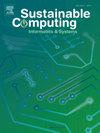Bio-inspired optimizer with deep learning model for energy management system in electric vehicles
IF 3.8
3区 计算机科学
Q1 COMPUTER SCIENCE, HARDWARE & ARCHITECTURE
引用次数: 0
Abstract
The rising popularity of electric vehicles (EVs) stems from their enhanced performance and environmental benefits. A critical challenge exists in optimizing the performance and extending the battery life of EVs, which depends on the accurate prediction of State of Charge (SOC) and State of Health (SOH). The Battery Management Systems (BMS) is essential for an EV’s Energy Management System (EMS). The current methodologies often fail to achieve the required precision, leading to suboptimal BMS that can compromise EV efficiency and reliability. To address these challenges, a merged SOC and SOH prediction approach is proposed. To maximize prediction accuracy, a hybrid Deep Learning (DL) model incorporating bio-inspired optimization algorithms such as Elephant Herding Optimization (EHO), Honey Badger Optimization (HBO), and Moth-Flame Optimization (MFO) is utilized. The architecture comprises two Convolutional Neural Networks (CNN) and an Autoencoder (AE), integrated with a Bidirectional Long Short-Term Memory (BLSTM) layer and a single Long Short-Term Memory (LSTM) layer for encoding and decoding tasks. The three optimized hybrid DL models were validated using standard benchmark datasets such as the Oxford Battery Aging Dataset, NASA, and CALCE. The prediction results of the merged SOC and SOH prediction from the three bio-inspired hybrid DL models were compared with those of the separate SOC prediction technique. The results of the merged SOC and SOH predictions were compared with traditional separate SOC prediction techniques, demonstrating superior performance. Notably, the HBO-Hybrid DL model achieved the highest R-squared (R2) values of 0.991 for SOC and 0.996 for SOH
基于深度学习模型的电动汽车能量管理系统仿生优化器
电动汽车(ev)的日益普及源于其增强的性能和环境效益。优化电动汽车的性能和延长电池寿命是一个关键的挑战,这取决于对充电状态(SOC)和健康状态(SOH)的准确预测。电池管理系统(BMS)是电动汽车能源管理系统(EMS)的关键。目前的方法通常无法达到所需的精度,导致BMS不理想,从而影响电动汽车的效率和可靠性。为了应对这些挑战,提出了一种融合SOC和SOH的预测方法。为了最大限度地提高预测精度,使用了混合深度学习(DL)模型,该模型结合了生物优化算法,如大象放牧优化(EHO)、蜜獾优化(HBO)和蛾焰优化(MFO)。该架构包括两个卷积神经网络(CNN)和一个自动编码器(AE),并集成了一个双向长短期记忆(BLSTM)层和一个长短期记忆(LSTM)层,用于编码和解码任务。使用牛津电池老化数据集、NASA和CALCE等标准基准数据集验证了这三种优化的混合深度学习模型。将3种生物动力混合深度深度模型的有机碳和SOH合并预测结果与单独的有机碳预测结果进行了比较。将合并后的SOC和SOH预测结果与传统的单独SOC预测技术进行了比较,结果表明合并后的SOC和SOH预测结果具有更好的性能。值得注意的是,HBO-Hybrid DL模型的SOC和SOH的r²(R2)值最高,分别为0.991和0.996
本文章由计算机程序翻译,如有差异,请以英文原文为准。
求助全文
约1分钟内获得全文
求助全文
来源期刊

Sustainable Computing-Informatics & Systems
COMPUTER SCIENCE, HARDWARE & ARCHITECTUREC-COMPUTER SCIENCE, INFORMATION SYSTEMS
CiteScore
10.70
自引率
4.40%
发文量
142
期刊介绍:
Sustainable computing is a rapidly expanding research area spanning the fields of computer science and engineering, electrical engineering as well as other engineering disciplines. The aim of Sustainable Computing: Informatics and Systems (SUSCOM) is to publish the myriad research findings related to energy-aware and thermal-aware management of computing resource. Equally important is a spectrum of related research issues such as applications of computing that can have ecological and societal impacts. SUSCOM publishes original and timely research papers and survey articles in current areas of power, energy, temperature, and environment related research areas of current importance to readers. SUSCOM has an editorial board comprising prominent researchers from around the world and selects competitively evaluated peer-reviewed papers.
 求助内容:
求助内容: 应助结果提醒方式:
应助结果提醒方式:


